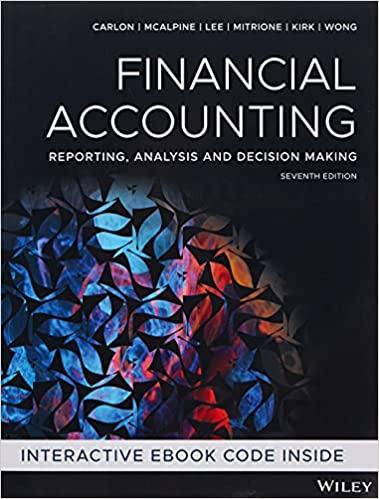Question
1-A The following transactions apply to Park Company for Year 1: Received $30,000 cash from the issue of common stock. Purchased inventory on account for
1-A
The following transactions apply to Park Company for Year 1:
- Received $30,000 cash from the issue of common stock.
- Purchased inventory on account for $144,000.
- Sold inventory for $173,500 cash that had cost $106,500. Sales tax was collected at the rate of 7 percent on the inventory sold.
- Borrowed $19,200 from First State Bank on March 1, Year 1. The note had a 7 percent interest rate and a one-year term to maturity.
- Paid the accounts payable (see transaction 2).
- Paid the sales tax due on $144,000 of sales. Sales tax on the other $29,500 is not due until after the end of the year.
- Salaries for the year for one employee amounted to $27,000. Assume the Social Security tax rate is 6 percent and the Medicare tax rate is 1.5 percent. Federal income tax withheld was $5,300.
- Paid $2,500 for warranty repairs during the year.
- Paid $12,500 of other operating expenses during the year.
- Paid a dividend of $5,000 to the shareholders.
Adjustments:
- The products sold in transaction 3 were warranted. Park estimated that the warranty cost would be 5 percent of sales.
- Record the accrued interest at December 31, Year 1.Record the accrued payroll tax at December 31, Year 1. Assume no payroll taxes have been paid for the year and that the unemployment tax rate is 6.0 percent (federal unemployment tax rate is 0.60 percent and the state unemployment tax rate is 5.40 percent on the first $7,000 of earnings per employee)
a.Required: a. Record the preceding transactions in general journal form. (If no entry is required for a transaction/event, select "No journal entry required" in the first account field.)
c-1. Prepare an income statement for Year 1. c-2. Prepare a statement of changes in stockholders equity for Year 1. c-3. Prepare a balance sheet for Year 1. c-4. Prepare a statement of cash flows for Year 1.
1-B
The following accounting information exists for Aspen and Willow companies.
| Aspen | Willow | |
|---|---|---|
| Cash | $ 17,000 | $ 27,000 |
| Wages payable | 19,500 | 22,500 |
| Merchandise inventory | 25,300 | 56,600 |
| Building | 50,000 | 100,000 |
| Accounts receivable | 32,650 | 32,375 |
| Long-term notes payable | 80,000 | 110,000 |
| Land | 50,000 | 50,000 |
| Accounts payable | 37,000 | 44,000 |
| Sales revenue | 210,000 | 290,000 |
| Expenses | 190,000 | 240,000 |
Required a-1. Determine the amount of current assets and current liabilities for each company. a-2. Compute the current ratio for each company. b. Assuming that all assets and liabilities are listed above, compute the debt-to-assets ratios for each company. c-1. Determine which company has the greater financial risk in the short term. c-2. Determine which company has the greater financial risk in the long term.
Step by Step Solution
There are 3 Steps involved in it
Step: 1

Get Instant Access to Expert-Tailored Solutions
See step-by-step solutions with expert insights and AI powered tools for academic success
Step: 2

Step: 3

Ace Your Homework with AI
Get the answers you need in no time with our AI-driven, step-by-step assistance
Get Started


